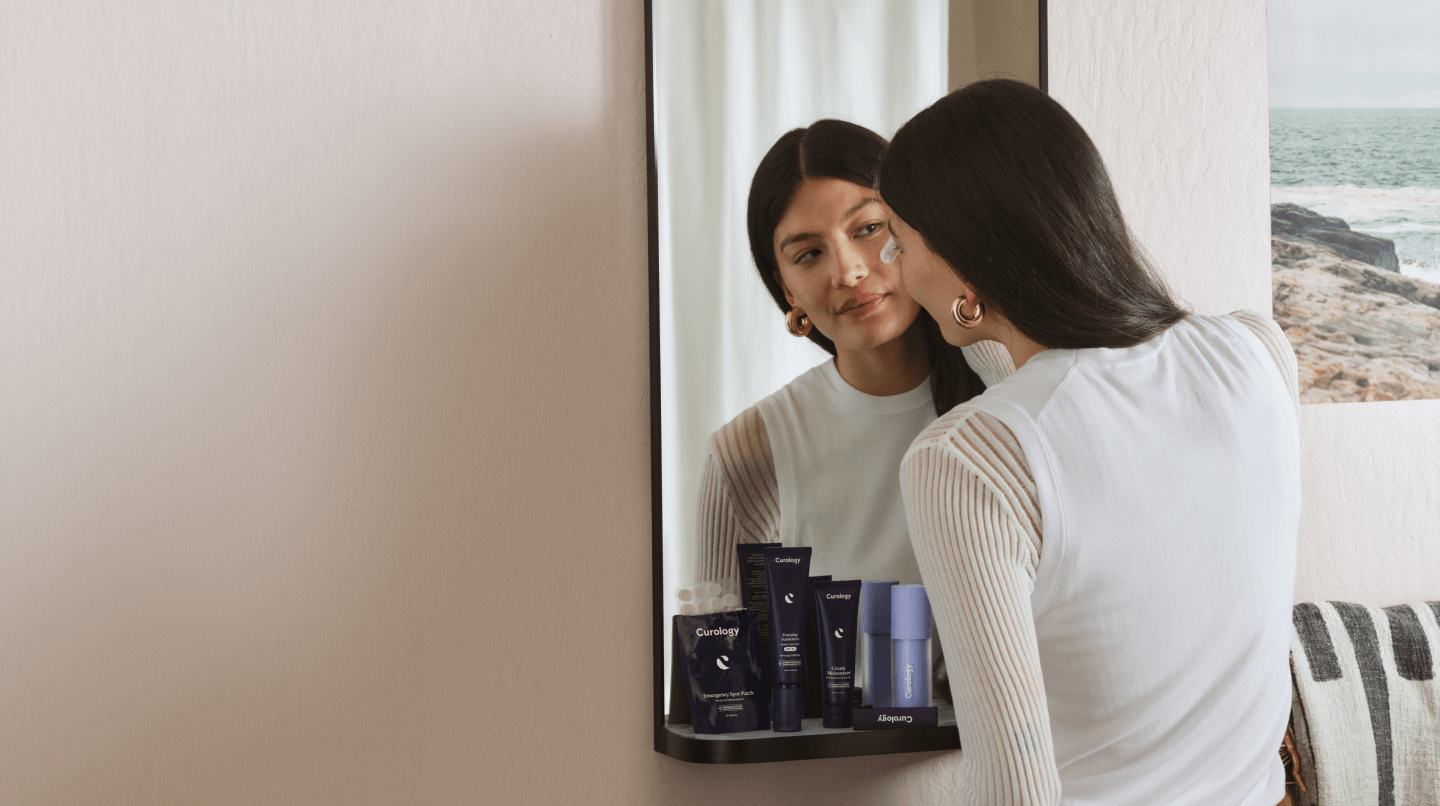How it works:
Share your skin goals and snap selfies
Your dermatology provider prescribes your formula
Apply nightly for happy, healthy skin
How it works:
How it works:
Share your skin goals and snap selfies
Your dermatology provider prescribes your formula
Apply nightly for happy, healthy skin
How it works:
Dysport vs. Botox: Comparing two popular anti-wrinkle treatments
Curology’s experts explain which injectable might be the best choice for your anti-aging goals.







First things first: When deciding which anti-wrinkle treatment is right for you or when pondering the nuances between Dysport and Botox, it’s always best to get professional medical guidance!
That’s why we asked two of our dermatology providers, Dr. Sonia Dulai, MD, and Stephanie Garbaczewski, PA-C, everything you might be curious about when it comes to these popular treatments. So, let’s get straight to it and examine their valuable advice regarding the differences, similarities, and real-world efficacy of Dysport and Botox as an anti-wrinkle treatment.
What is Dysport?
DYSPORT® (abobotulinumtoxinA) is a neuromodulator used for medical and cosmetic treatments. Medically speaking, it’s used to treat adults dealing with involuntary neck spasms¹ known as cervical dystonia,² and it’s also proven useful for those struggling with muscle stiffness,³ also known as spasticity.⁴ That’s not all: On the beauty front, it can smooth out glabellar lines,⁵ those persistent frown lines that appear between your eyebrows.⁶
It’s clear this neuromodulator offers many benefits, but how exactly does it work against wrinkles? Allow us to explain.
How Dysport helps against wrinkles
When Dysport is injected, it blocks signals from your nerves to your muscles, basically telling them to take a little break.⁷ The result? Your muscles relax, and those wrinkles or fine lines you’ve noticed start to look smoother.
Stephanie Garbaczewski, PA-C, tells us that one advantage of Dysport is its fast onset of action: People usually see noticeable improvements in just two to three days.⁸ The effects typically last 3-6 months,⁹ offering a relatively long-term solution for maintaining a wrinkle-free complexion.
What is Botox?
When we asked Dr. Sonia Dulai to shed some light on Botox, she told us that Botox and Dysport are like close relatives. They share the same main ingredient but have minor differences, like concentration levels and the presence or absence of binding proteins.
That’s good news because if one doesn't do the trick for you, the other might.
Botox is a multitasker. On the medical side, it’s used for issues like chronic migraines and muscle spasms.¹⁰ But it’s also a go-to for cosmetic treatments, like ironing out those facial wrinkles. Both Botox and Dysport belong to a particular category of meds called neurotoxins, so they’re trusted for a range of treatments in the medical world.
How Botox helps against wrinkles
Botox helps smooth out wrinkles by temporarily making the muscles under your skin relax. It does this by interfering with the signals that nerves send to muscles. Normally, nerves release a chemical that tells your muscles to move. Botox blocks this chemical, so the muscle doesn’t get the full message to contract, making your skin appear smoother and less wrinkled.¹¹
Garbaczewski notes, Botox is also “commonly recommended for large pores and skin texture concerns, as it creates a ‘dewy’ look, giving the appearance of a slight filter on the face at all times.”
She also mentions that the effects of Botox typically become noticeable within 5-7 days and can last around 3-6 months. This makes it a practical option for anti-aging, as it can smooth out wrinkles and give skin a more youthful appearance.
Which one is better for wrinkles, Dysport or Botox?
Choosing between Dysport and Botox for wrinkle treatment depends on various factors, and neither is definitively “better” than the other; both have their strengths. They both work by relaxing underlying facial muscles to smooth out wrinkles, commonly targeting areas like crow's feet, forehead lines, and “11 lines.”
When we asked our medical experts, they pointed out some key factors to consider:
Onset of Action & Duration: Dysport typically shows results in 2-3 days,¹² while Botox takes about 5-7 days. Both generally last around 3-6 months. Dulai says, “I appreciate Dysport’s quick onset of action, duration, and consistency of results, and less post-injection aching! I feel results for both last around four months; however, if a patient continues to get injected at the same site, they may experience longer results due to muscle atrophy.”
Cost: Garbaczewski adds, “Dysport may be less expensive than Botox in some facilities, although Botox often runs specials and has a loyalty program (Alle).”
Area of Treatment: These treatments may work better on different areas of your face. Dulai suggests that “for a forehead, Dysport may work better since the molecular weight is low and it can diffuse nicely over the forehead. For small targeted areas like crow’s feet, Botox may be preferred.”
Other Factors: Botox has been approved for treating chronic migraines and can be an adjunctive benefit in laser skin treatments.¹³ As Dulai points out, “patients undergoing laser may opt for Botox.”
The choice between Dysport and Botox is highly individual and should be made in consultation with a qualified medical provider who can assess your specific needs. Both can provide excellent results, but the best option for you depends on your personal preferences, the area being treated, and other considerations.
Adverse effects
Dysport and Botox are generally considered safe and well-tolerated for cosmetic uses such as wrinkle treatment. However, they’re not without potential adverse effects.
According to our experts, the most common side effects for both treatments may include:
Temporary bruising
Redness and swelling
Mild discomfort
Headaches
Drooping of nearby muscles
These adverse effects are typically mild and temporary. Research over the past decade supports the safety of these treatments for cosmetic purposes. One study involving 1,415 patients over a 2-year period found no new safety risks, even with repeated treatments. Most observed side effects were mild or moderate.¹⁴
So, while Dysport and Botox come with a risk of side effects, these are generally manageable and temporary, mainly when a qualified medical professional administers treatment.
Attaining younger-looking skin with Curology
Both Dysport and Botox have their merits when it comes to treating wrinkles and offering a more youthful appearance. Your choice will depend on factors such as onset of action, duration, and the specific area being treated. It’s also essential to consider costs, as noted by our medical professionals Stephanie Garbaczewski, PA-C, and Dr. Sonia Dulai, MD. Remember, these are our general recommendations, but you should always consult with a qualified in-person healthcare provider to determine the best option for your individual needs.
Get your personalized skincare routine with Curology
Get your personalized skincare routine with Curology


Are you interested in future-proofing your skin even further? Check out Curology’s HydroTretᴿˣ for anti-aging for more skincare solutions.
FAQs
According to Stephanie Garbaczewski, PA-C, both of these treatments generally last between 3 and 6 months. Interestingly, most of her patients return for a follow-up treatment around the fourth month. That suggests that for many people, there needs to be a clear winner between Botox and Dysport when it comes to how long the effects last. Both options offer a similar duration of results.
When it comes to Dysport vs. Botox, there’s no one-size-fits-all answer. The choice between the two largely hinges on individual preferences, specific needs, and medical advice. Dr. Sonia Dulai even points out some nuanced differences, like Dysport’s faster onset of action and potentially better performance on the forehead. In contrast, Botox might be preferable for smaller targeted areas like crow’s feet.
Stephanie Garbaczewski, PA-C, highlights that Dysport may be slightly less expensive than Botox at some facilities. However, it’s important to consider that costs can vary depending on where you’re getting the treatment, among other factors.
The most common side effects for both Dysport and Botox include temporary bruising, redness and swelling, mild discomfort, headaches, and drooping of nearby muscles. These side effects are generally mild and temporary, especially when administered by a qualified medical professional. Both treatments have been extensively studied and are considered safe and well-tolerated for cosmetic uses.
Yes, you can switch between Dysport and Botox, as they are closely related treatments with the same main ingredient. If one treatment doesn't yield the desired results, the other might. However, it's essential to consult with a qualified medical provider for personalized advice, as there are nuanced differences between the two, such as onset of action, cost, and suitability for treating specific facial areas.
There’s no one-size-fits-all in skincare. What works for one person may not necessarily have the same results for someone else. But it’s only natural to want the best! Luckily our team of licensed dermatology providers are regularly reviewing and assessing products on the market and are happy to offer a few recommendations! So here, you’ll find the products that hold up to our standards.
P.S. We did the homework, so you don’t have to:
Cunha, B., et al. Torticollis. StatPearls. (2023, August 8).
National Institutes of Health. Dysport. DailyMed. (2023, January 31).
Rivelis, Y., et al. Spasticity. StatPearls. (2023, August 8).
National Institutes of Health. Dysport. DailyMed. Ibid.
National Institutes of Health. Dysport. DailyMed. Ibid.
Walker, H.M. and Chauhan, P.R. Anatomy, Head and Neck: Glabella. StatPearls. (2023, July 24).
Field, M., et al. AbobotulinumtoxinA (Dysport®), OnabotulinumtoxinA (Botox®), and IncobotulinumtoxinA (Xeomin®) Neurotoxin Content and Potential Implications for Duration of Response in Patients. Toxins (Basel). (2018, December 13).
Nestor, M., et al. Onset and Duration of AbobotulinumtoxinA for Aesthetic Use in the Upper face: A Systematic Literature Review. J Clin Aesthet Dermatol. (December 2020).
Nestor, M., et al. Onset and Duration of AbobotulinumtoxinA for Aesthetic Use in the Upper face: A Systematic Literature Review. J Clin Aesthet Dermatol. Ibid.
Padda, I.S. and Tadi, P. Botulinum Toxin. StatPearls. (2023, June 3).
Padda, I.S. and Tadi, P. Botulinum Toxin. StatPearls. Ibid.
Nestor, M., et al. Onset and Duration of AbobotulinumtoxinA for Aesthetic Use in the Upper face: A Systematic Literature Review. J Clin Aesthet Dermatol. Ibid.
Yamauchi, P.S., et al. Botulinum toxin type A gives adjunctive benefit to periorbital laser resurfacing. J Cosmet Laser Ther. (November 2004).
Nestor, M., et al. Onset and Duration of AbobotulinumtoxinA for Aesthetic Use in the Upper face: A Systematic Literature Review. J Clin Aesthet Dermatol. Ibid.
Camille Dixon is a certified Physician Assistant at Curology. She received her Master of Medical Science in Physician Assistant Studies from Midwestern University in Downers Grove, IL.
*Cancel anytime. Subject to consultation. Results may vary.

Curology Team

Camille Dixon
Related Articles
Which tretinoin is right for you, according to Vogue? How to help stop a rash from spreading, according to skin experts How to treat atrophic scars: Here’s what you need to knowFace sunscreen for normal skinSun protection for melanin-rich skinPopular Articles
Ask Curology: Is my cold breaking me out?Slugging: The dermatologist-approved skincare hack going viral on TikTokTretinoin vs retinol: What’s the difference?How to create a self-care routine that actually sticksYour 2023 skincare horoscopeTry prescription skincare
Get routine essentials


Face what’s next with Future-ProofRx
Face what’s next with Future-ProofRx
- Skin texture
- Fine lines
- Wrinkles
- Dark spots
- Dullness
$29.95/month